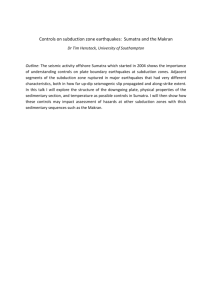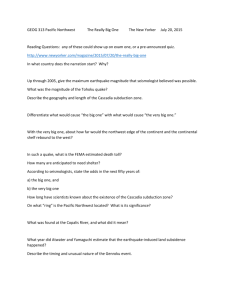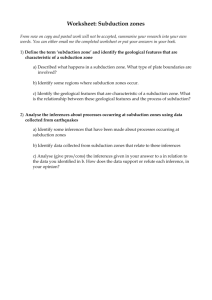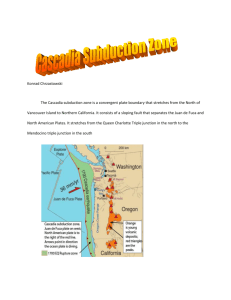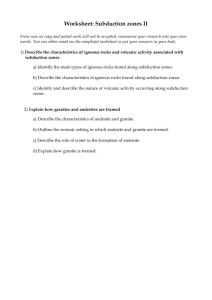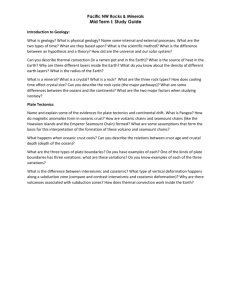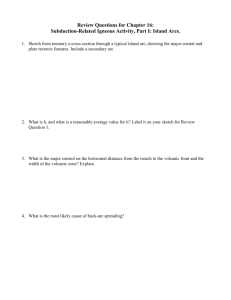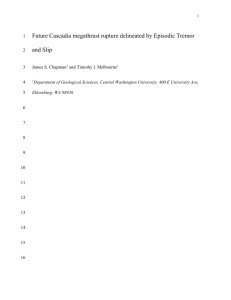carver_1998_paleosei..
advertisement
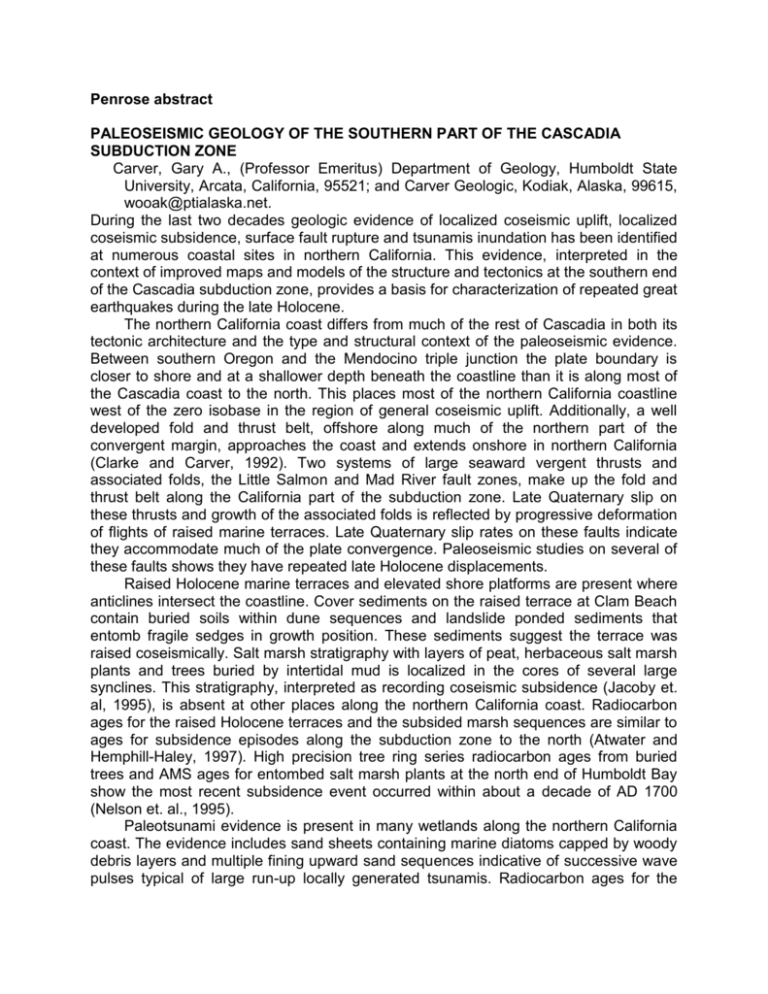
Penrose abstract PALEOSEISMIC GEOLOGY OF THE SOUTHERN PART OF THE CASCADIA SUBDUCTION ZONE Carver, Gary A., (Professor Emeritus) Department of Geology, Humboldt State University, Arcata, California, 95521; and Carver Geologic, Kodiak, Alaska, 99615, wooak@ptialaska.net. During the last two decades geologic evidence of localized coseismic uplift, localized coseismic subsidence, surface fault rupture and tsunamis inundation has been identified at numerous coastal sites in northern California. This evidence, interpreted in the context of improved maps and models of the structure and tectonics at the southern end of the Cascadia subduction zone, provides a basis for characterization of repeated great earthquakes during the late Holocene. The northern California coast differs from much of the rest of Cascadia in both its tectonic architecture and the type and structural context of the paleoseismic evidence. Between southern Oregon and the Mendocino triple junction the plate boundary is closer to shore and at a shallower depth beneath the coastline than it is along most of the Cascadia coast to the north. This places most of the northern California coastline west of the zero isobase in the region of general coseismic uplift. Additionally, a well developed fold and thrust belt, offshore along much of the northern part of the convergent margin, approaches the coast and extends onshore in northern California (Clarke and Carver, 1992). Two systems of large seaward vergent thrusts and associated folds, the Little Salmon and Mad River fault zones, make up the fold and thrust belt along the California part of the subduction zone. Late Quaternary slip on these thrusts and growth of the associated folds is reflected by progressive deformation of flights of raised marine terraces. Late Quaternary slip rates on these faults indicate they accommodate much of the plate convergence. Paleoseismic studies on several of these faults shows they have repeated late Holocene displacements. Raised Holocene marine terraces and elevated shore platforms are present where anticlines intersect the coastline. Cover sediments on the raised terrace at Clam Beach contain buried soils within dune sequences and landslide ponded sediments that entomb fragile sedges in growth position. These sediments suggest the terrace was raised coseismically. Salt marsh stratigraphy with layers of peat, herbaceous salt marsh plants and trees buried by intertidal mud is localized in the cores of several large synclines. This stratigraphy, interpreted as recording coseismic subsidence (Jacoby et. al, 1995), is absent at other places along the northern California coast. Radiocarbon ages for the raised Holocene terraces and the subsided marsh sequences are similar to ages for subsidence episodes along the subduction zone to the north (Atwater and Hemphill-Haley, 1997). High precision tree ring series radiocarbon ages from buried trees and AMS ages for entombed salt marsh plants at the north end of Humboldt Bay show the most recent subsidence event occurred within about a decade of AD 1700 (Nelson et. al., 1995). Paleotsunami evidence is present in many wetlands along the northern California coast. The evidence includes sand sheets containing marine diatoms capped by woody debris layers and multiple fining upward sand sequences indicative of successive wave pulses typical of large run-up locally generated tsunamis. Radiocarbon ages for the paleotsunami sands from the south part of Humboldt Bay, Lagoon Creek, and Crescent City for the last 5 events are indistinguishable at the 2 sigma level from ages for Cascadia earthquakes on the Washington coast (Atwater and Hemphill-Haley, 1997). At several locations the tsunami sands are stratigraphically related to indicators of strong shaking including landslides and liquifaction and to sedimentologic, macro-floral and diatom evidence of coseismic subsidence. At least two short subduction zone segments with slip histories different than the rest of Cascadia are present in the Mendocino triple junction region. These segments are kinematically defined by differences in convergence direction and rate resulting from the intersection of the subduction zone with the wide San Andreas and Mendocino fault - Gorda deformation zone transform systems (Tanioka et. al., 1995). In 1992 the southern segment ruptured and produced the Mw 7.2 Petrolia earthquake and up to 1.4 meters of coseismic uplift on a ~24 kilometer long section of coast south of Cape Mendocino. Tree ring series radiocarbon ages for subsided and buried trees in the Eel River delta on the northern segment indicate its last rupture occurred in the early 1800s. These segments constitute additional subduction earthquake sources at the south end of the Cascadia subduction zone. Taken together, the paleoseismic evidence for Cascadia earthquakes in northern California suggests the subduction zone north of Humboldt Bay has a late Holocene seismic history that is similar to the rest of the Cascadia subduction zone in the Pacific Northwest. In northern California past great Cascadia earthquakes have included rupture of fold and thrust belt faults, particularly the Little Salmon fault, and growth of associated folds. This upper plate deformation accommodated much of the plate convergence. Coseismic elevation changes along the coast have been associated with the upper plate structures. Coseismic subsidence has been confined to syncline axis while uplift occurred where anticlines intersect the coast. Large tsunamis were produced during each late Holocene event. The timing of the last 5 northern California Cascadia earthquakes can not be differentiated on the basis of radiocarbon ages from those originating further north along the Washington coast, suggesting most of the subduction zone may be unsegmented during most seismic cycles. Two short subduction zone segments with different slip histories are recognized in the Mendocino triple junction region. The southern of these ruptured in 1992, and the northern segment probably last ruptured in the early 1800s. Atwater, B.F., and Hemphill-Haley, E., 1997, Recurrence intervals for great earthquakes of the past 3500 years at northeastern Willapa Bay, Washington: U.S. Geological Survey Professional Paper 1576, 108 p. Clarke, S. H. and Carver, G. A., 1992, Late Holocene tectonics and paleoseismicity, southern Cascadia subduction zone, Science, 255, p. 188-191. Jacoby, G., Carver, G., and Wagner, W., 1995, Trees and herbs killed by an earthquake ~300 yrs. ago at Humboldt Bay, California, Geology, v. 23, no. 1, p. 77-80. Nelson, A., Atwater, B., Benson, B., Bobrowsky, P., Bradley, L., Clague, J., Carver, G., Darienzo, M., Grant, W., Krueger, H., Sparks, R., Stafford, T., and Stuiver, M., 1995, Radiocarbon evidence for extensive plate-boundary rupture about 300 years ago at the Cascadia subduction zone, Nature, v.378, no. 6555, p. 371-374. Tanioka, Y., Satake, K., and Ruff, L., 1995, Seismotectonics of the April 25, 1992 Petrolia earthquake and the Mendocino triple junction region, Tectonics, 14, 5, p. 1095-1103.

